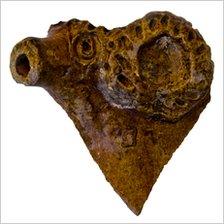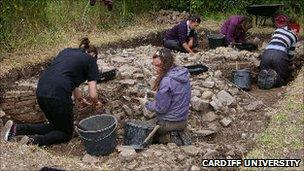Cosmeston pottery find shows a thriving medieval craft
- Published

A ram's head is the most distinctive piece of the vessel to have been found
A 13th Century pottery vessel found in the Vale of Glamorgan could indicate a thriving local craft in medieval times.
Several fragments of the aquamanile, decorated with a ram's head, were discovered at the site of a manor house at Cosmeston, near Penarth.
The vessels were used by guests to wash their hands at the dinner table.
Professor John Hines from Cardiff University, leader of the dig, said they had never found such an elegant piece made from the local Vale Ware.
The 20-strong team from the university's school of history, archaeology and religion has been digging at the Cosmeston medieval village for the last 4 years.
They have been exploring the site of a manor house, which had not been excavated when archaeology work was first carried out in the area in the 1980s.
The pottery shards were found just outside the original manorial hall, amongst the debris of a large and well built medieval building.
The archaeologists have identified the pottery as Vale Ware, examples of which have been found at sites across south Wales.
Finds co-ordinator Alice Forward said simpler vessels with ram's heads were not uncommon.
But she said the decoration of the ram's nose as a pouring spout was particularly interesting, along with the fact that it was made from local clay rather than imported.
"We've always known about the manorial estate but the amount of highly decorative pottery we've found including French tableware shows we're looking at a high status family, more wealthy than we'd realised," she said.
Prof Hines agreed that the discovery shed new light on the fate of the de Costentin family, who were lords of the manor until they were displaced in the mid 1310s.
"It shows they weren't the family of a poor knight on their uppers, but living a much better life than we'd previously thought," he said.

The university has been digging at the Cosmeston site for four years
"It's easy to presume they would have imported their tableware from Bristol and elsewhere.
"But this shows there was enough money in the area and skilled workers available to support a local industry."
Archaeologists are inviting members of the public to visit the excavation as part of a medieval event on Saturday and Sunday.
Members are also giving free tours of the site every day until 18 July.